A Fashionable Encounter: Artificial Intelligence Meets the Atelier
In a world where high-end fashion experiences are delivered through virtual screens and right at the consumers’ doorsteps, the advancement of Artificial Intelligence [“AI”] into Luxury Fashion Retail is no longer a distant dream, but a glamorous force reshaping the contours of this industry. With virtual assistants and AI-powered digital stylists available at the click of a button, the essence of AI’s integration into luxury fashion can be captured in three C’s: Code, Couture and Convenience; with convenience being the operative term. From trend forecasting and demand-driven inventory optimization to hyper-personalized consumer experiences, AI has forged a seamless and ‘convenient way’ of operationalizing the fashion retail sector.
Putting the 3C’s to practice, luxury fashion houses and conglomerates are rapidly shifting to the digitally draped future – with Hermès recently introducing a virtual try-on makeup tool for its lip shades and cosmetic range, and Prada’s partnership with Databricks efficiently integrating AI-driven data analytics for forecasting models, optimizing marketing initiatives, and reshaping personalized experiences in-store and online.
While these ‘technological accessories’ adorn retail operations and experiences both on- and off-screen, they also raise critical legal and ethical concerns with respect to consumer rights, data protection, intellectual property safeguards, algorithmic bias, and beyond. The sensitive nature of these concerns makes it imperative that the employment of AI in luxury fashion retail is both morally aligned and legally sound. With legal frameworks still in their nascent stages concerning AI, it is imperative for luxury fashion houses to strike a balance between operational efficiency and robust consumer safeguards, while managing the resource and investment-intensive nature of these innovations. This necessitates a careful examination of how AI is transforming the high-end fashion retail sector and intersecting with legal rights and ethical concerns.
Against this backdrop, this article aims to analyze the scope of AI in redefining luxury fashion retail, assessing its operations through the lens of inevitable legal and ethical dilemmas. Catering to real-life instances and a cross-jurisdictional perspective, the article critically evaluates the present and future impact of AI in this industry.
Integration of AI in Luxury Fashion Retail: An Inside Scoop
This section will untangle the intricacies of the role of AI in refining luxury fashion retail operations and consumer experiences. AI’s profound impact in this sector is manifested in several ways – from design generation to product lifecycle management, the runway algorithm sparks more than just consumer experiences and choices. The following discussion primarily sheds light on three key integration areas: (I). Consumer Experience and Personalization, (II). Supply Chain and Inventory Optimization, and (III). Trend Forecasting and Design Innovation.
Consumer Experience and Personalization
Luxury fashion houses, including Chanel, Gucci and Louis Vuitton [“LV”] have ventured into the AI-fashion space by providing realistic and hyper-personalized retail experiences to consumers in their comfort zone. By introducing the concept of Virtual Try-Ons and Fittings, consumers are now able to replicate in-store shopping experiences in their living rooms, or any corner of the world, all digitally wrapped into their smart devices.
Not only does this save time and effort, but it also helps fashion enthusiasts make informed choices before investing in a luxury product. The Personalized style assistants and virtual catalogues further add a shimmery layer to the overall shopping experience.
AI has also made it possible for consumers to seamlessly try on products from across the world, despite the regional unavailability of stock. For instance, LV recently launched La Beatué Louis Vuitton, a luxury beauty line reflecting the iconic Maison’s exceptional craftsmanship in a range of selective cosmetic products. Being an inaugural initiative in this domain, the product line is only available at select beauty boutiques in specific locations. While these products are presently not available for retail in India, LV’s AI-powered virtual try-on feature allows users to experience the brand experience and specific shades online, even in the absence of geographic availability. If someone from India were to opt for cross-border shipping or procure the beauty line from elsewhere, they could exercise the convenient option of engaging with the products in a realistic setting offered virtually. AI continues redefining personalized consumer experiences in the following ways:
Virtual Try-Ons and Fittings
A Virtual Try-On is a mechanism that allows users to engage with an immersive real-life setting to visualize how different garments or accessories may be styled as per their preferences without physically trying them on. With the integration of machine learning algorithms and augmented reality [“AR”], AI can predict how different fabrics or products will look on different body types and allow users to engage with this technology in real-time.
Virtual try-ons also take into account the lighting, angles and different dimensions to provide a more realistic shopping experience. By utilizing computer vision, AI captures users’ body-image scans with consent and carefully traces movements, gestures and expressions to ensure accurate and proper placements of try-ons and fittings.
Various high-end fashion houses have adopted this technology by partnering with tech companies and other stakeholders to do away with the stringent reliability on physical fitting rooms and in-store visits in order to experience a personalized shopping experience. As a pioneering initiative into adopting the AR technology, Gucci offered its consumers a virtual-shoe fitting tool on its e-commerce platform back in 2019, a feature that allowed users to visualize how different footwear would realistically look on them without having to physically try them on. Another notable example includes the ‘Virtual Makeup Studio’ offered by Chanel, which enables users to mindfully pick their cosmetic shades and products based on their visual appearance, finishing and texture – almost like a customized look-book!
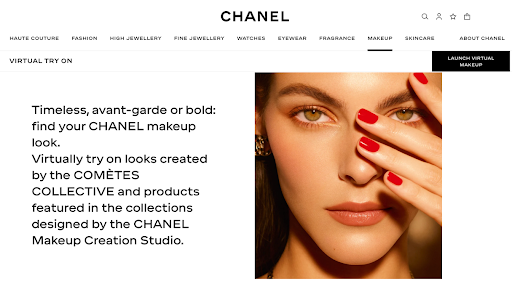
With the AR market expected to record a $598 billion [USD] revenue by 2030, it has demonstrated impeccable consumer feedback and repetitive purchase history, with over 72% of luxury fashion consumers preferring an immersive AR experience as part of their shopping spree.
Digital Stylists and Virtual Assistants
AI-powered Fashion Chatbots and virtual assistants are consistently redefining consumer interaction by translating lookbooks into hyper-personalized, real-time assistance – without calling for an appointment with a personal stylist or shopper. Fashion Chatbots, for instance, take into consideration the users’ measurements, style and occasion preferences, and even brand suggestions while curating a customized style-board. Style DNA, an AI-powered personal stylist, records users’ preferences by asking them to opt for specific style goals, favored brand selection, body measurements and even facial image scans before generating customized recommendations. The images below illustrate the engaging interface of the app that collects and processes consumer inputs.

This mechanism integrates natural language processing with machine learning algorithms to meticulously analyze consumer preferences before generating an appropriate response. Fashion AI Chatbots are also well-equipped with tracing and studying the users’ browsing and purchase histories, in order to blend their preferences before providing style-related suggestions.
While this practice poses significant data protection and privacy risks, some consumers seem to enjoy the convenience of engaging with these virtual tools in the absence of human stylists and shoppers – a recent CGS survey assessed the impact of integration of AI in consumer service on 1,000 U.S. Consumers, and showcased that while a majority of consumers still opted for human assistance over AI, around 30% consumers preferred virtual assistance, believing that “chatbots and virtual assistants make it easier to address consumer service issues”.
Earlier this month, Ralph Lauren launched its AI-driven virtual stylist and fashion chatbot, Ask Ralph, developed in collaboration with Microsoft. This tool leverages generative AI to respond promptly to consumer styling queries, along with curating occasion-oriented outfit recommendations and lookbooks, effectively functioning as a digital fashion concierge and extending Ralph Lauren’s timeless luxury experience into the realm of the virtual world.
The following image provides a glimpse of the Ask Ralph interactive styling tool in full swing:

While AI adorns the ‘luxury fashion moments’ for consumers, it continues to leave its imprint on the ‘behind-the-curtains’ moments as well – making its way into the operational frameworks of the backstage world, where it orchestrates supply chains, forecasts trends and safeguards brand integrity.
Supply Chain and Inventory Optimization
Generative-AI has emerged as an exceptional tool in the luxury fashion retail sector, in terms of optimizing production cycles by reducing costs and improving the overall operational efficiency. By processing and analyzing extensive data pertaining to vendors, production capacities, transportation logistics, and lead times, AI can generate brand-specific strategies for inventory management, allocation, and production planning, thereby curating a streamlined production process – just like a perfectly fitted gown tied up in a glittered virtual ribbon. This section highlights AI’s impact across two pivotal domains: inventory management and logistics, and product lifecycle management.
Inventory Management and Logistics
AI has demonstrated remarkable efficiency in optimizing inventory and logistical operations. Advanced machine learning algorithms forecast potential disruptions, trace viable shipping routes, and even help bridge the gap between suppliers and fashion retailers, thereby enhancing logistical functionality and effectiveness to the overall process.
Inventory optimization using AI-powered tools makes the luxury fashion retail process more structured and cohesive. By analyzing real-time inputs, AI continuously adjusts and updates stock levels, keeping the retailer informed of availability and anticipating demand trends. This helps minimize overstock, prevent shortages and maintain smooth operations – ensuring every display and purchase remains flawless, while preserving the luxury shopping experience. Recent studies indicate that AI-driven forecasting can minimize errors by 20-50%, in comparison to the traditional retailing methods. A recent McKinsey & Co. report noted that AI can significantly reduce operational and logistics costs, with brands recording a drop of up to 15% and service levels demonstrating improvement by 65%. Additionally, AI-driven inventory management mechanisms have also recorded 65% reduced stockouts, with increased sales.
These efficiencies can be observed in practice: Burberry, for instance, has integrated an AI-powered inventory management mechanism into its retail operations, employing real-time data analysis to consistently monitor slow-moving stock and inventory levels, thereby efficiently adjusting its global distribution, while LVMH is adopting AI-embedded inventory management systems and smart warehousing practices to align inventory with production capabilities.
Product Lifecycle Management
Product Lifecycle Management [“PLM”] refers to the systematic process of managing a product’s journey, right from its inception and launch till its final disposal or delisting. The PLM process broadly encompasses the following stages: (i). Conceptualization, (ii). Design and Development, (iii). Production and Launch, (iv). Service and Support, and (v). End- of- Life [discontinuation/ removal].
AI enhances PLM for luxury fashion brands by analyzing historical and real-time sensor data to predict maintenance needs, coordinating material and component flows, monitoring documentation and internal communications within PLM systems, and conducting predictive analyses to extend product lifespan, among other actions.
Luxury fashion brands have also collaborated with stakeholders to integrate blockchain technology into their PLM processes – for instance, LVMH developed the first global luxury blockchain, the “Aura Blockchain Consortium”. Through ‘Digital Product Passports’, the system collects and shares product data throughout its lifecycle, highlighting sustainability attributes. Beyond supply chain and inventory optimization, AI also powers trend forecasting and design innovation, creating fashion retail magic.
Trend Forecasting and Design Innovation
AI deploys advanced algorithms to analyze consumer behavior, preferences, style archives, cultural shifts, and social media patterns to anticipate forthcoming fashion trends with remarkable precision. Further, generative AI has expanded the horizons of creativity for designers and labels by offering stellar fashion templates and novel design frameworks. Together, these technological capabilities allow luxury fashion brands to align their commercial interests with creative direction, while still preserving their identity and heritage.
Trend Analysis and Forecasting
AI processes and analyzes millions of data points in real-time to forecast fashion trends. In fact, studies have reported that AI-powered trend analysis has led to inventory waste reduction for fashion brands by 30-50%. AI redefines the trend analysis process by integrating its advanced pattern recognition algorithms, extensively identifying recurring color schemes, motifs, elements, themes across diverse datasets; all of which stems from its excellent ability to gather and analyze significant amounts of data – AI systems can effectively retrieve and study from thousands of sources available across the web, including social media and other online publications to conduct predictive analysis and generate information on consumer preferences and potential incoming trends.
Additionally, AI also monitors and meticulously traces brands’ competitors in the fashion industry, and offers tailored and strategic solutions for trend analysis and forecasting.
AI has embarked on its virtual footsteps into the fashion forecasting world, and the same can be observed in practice: from luxury fashion houses to multi-branded retail platforms, the dominant players in the industry seem to employ AI-driven mechanisms for effective trend analysis and forecasting. One notable example is that of Net-a-Porter, a luxury fashion retailer that leverages AI-powered trend forecasting to successfully predict consumer demands and personalize offerings.
Design Innovation
AI is revolutionizing the creative space by processing all sorts of creative ideas, wrapped in prompts and unstructured data [including raw text, sketches, video clips, and images] to transform them into fresh, fashionable outputs– including fully written scripts and fashion guides for design curation and innovation, conceptualizing, and even generating three-dimensional designs. McKinsey’s analysis on the future of generative AI in the fashion and luxury sector unveils that this technological advancement could contribute up to $275 billion in the next 3-5 years to the industry.
Platforms like The New Black AI provide cutting-edge technology and design curation tools, enabling thousands of fashion designers and creators to generate unique designs by analyzing raw inputs, including designers’ preferences, fabric and color palette specifications, creative ideas and patterns.
While the issue of AI-generated designs often sparks concerns over authorship and ownership, luxury fashion houses have put in motion the algorithm to the atelier, with IP safeguards intact, of course – last year, for instance, Moncler collaborated with Lulu Li, a Chinese artist to integrate her AI-generated designs into its ready-to-wear collection, in a fashionably historic move.
AI in Luxury Fashion Retail Through a Legal Lens
AI offers groundbreaking and convenient solutions to everyday fashion retail operations, yet its impact on consumer rights and broader legal complexities cannot be ignored. The integration of AI systems presents an intricate web of legal and ethical concerns, which must be carefully resolved before being deeply stitched into the fabric of luxury fashion retail. While AI-powered optimization techniques and personalized consumer experiences sprinkle glitter onto luxury retail, their sparkle ultimately depends on the timely identification and resolution of the legal challenges they entail. After all, nobody wants glitter in the wrong places, because it’s glamorous only until it ends up in your eyes when trying on a sequined dress.
This section examines the legal implications of AI in the luxury fashion retail sector through three core dimensions: (I). Data Privacy (II). Consumer Protection and (III). Intellectual Property Safeguards – primarily derived from India’s legal and regulatory framework, alongside cross-border perspectives from the United States [“U.S.”], and the European Union [“EU”].
Data Privacy
Virtual shopping experiences rely heavily on the collection of consumers’ biometric data, with AI-powered systems often collecting highly sensitive personal data, including facial scans, movements, gestures, body measurements, and sometimes even voice samples or behavioral profiles. Additionally, when AI is involved in trend analysis and forecasting, it works with large data sets, combining machine learning algorithms and deep neural networks to identify and predict fashion trends. In this process, extensive data, including consumer information, is unknowingly collected from multiple sources, which is then analyzed to identify existing patterns and generate new ones. A few notable data collection tools include:
- Application Programming Interface [“API”]: API refers to a set of protocols that allows data exchange and communication between two or more software applications. In this way, social media sites and e-commerce retail platforms interact to share users’ browsing and purchase histories. This practice especially becomes relevant when APIs start analyzing ‘text sentiment data’ from these applications, where consumers often manifest their fashion preferences.
- Natural Language Processing [“NLP”]: NLP refers to the ability of AI models to understand, analyze and generate language that closely replicates human communication. NLPs can extract consumer data for fashion trend forecasting and analysis in several ways, including ‘topic modelling’ to identify recurring preferred themes among consumers based on their digital footprint, and tracking user activities across the web.
A mechanism that is so deeply ingrained in the practice of collecting and processing personal data, despite obtaining user consent, at least for certain stages of the process, inevitably raises concerns with respect to its transparent and fair management. Hence, consumer privacy issues are bound to arise with the adoption of AI techniques in luxury fashion retail.
Indian Legal Perspective
India is yet to formulate an AI-specific legislation to govern and standardize its usage across the country. However, notable developments have recently come to the fore within the sphere of AI-related data privacy concerns – including the National Strategy for AI, 2018, and the Complex Adaptive System [CAS] Framework to Regulate Artificial Intelligence, 2024. Much like other jurisdictions in their blossoming stages with respect to AI regulation, India has relied on pre-existing legal frameworks to address emerging developments and issues within this realm. Therefore, data privacy and protection concerns continue to be addressed under the general data protection regimes.
The Digital Personal Data Protection Act [“DPDP Act”], 2023, presently constitutes the landmark legislation governing personal data processing in India, establishing important compliance obligations for commercial stakeholders deploying AI mechanisms. Although the DPDP Act does not expressly incorporate AI-specific provisions, the Ministry of Electronics and IT, Government of India [“MeitY”] confirmed that it is applicable to AI-related concerns regarding data privacy. This Act will also regulate the extraction of personal data without users’ consent and its misuse thereof, including deepfakes and other malpractices. By adopting a consent-based framework requiring explicit user-consent for data collection and processing, the DPDP Act fundamentally transforms how brands collect, store and manage customer information, an approach that becomes particularly relevant in the context of AI-powered personalization and virtual try-on technologies.
The Information Technology Act, 2000 [“IT Act”] also governs the misuse of personal and unauthorized data by intermediaries, and includes the imposition of penalties for impersonation and privacy violations, as provided under Sections 66D and 66E, respectively. Further, the Information Technology (Intermediary Guidelines and Digital Media Ethics Code) Rules, 2021 [“IT Rules”] extend their ambit to data privacy violations that may arise from AI-usage. Notably, Rule 3(2)(B) of the IT Rules mandates strict directives for intermediaries to remove or disable access to manipulated or unauthorized content, including “artificially morphed images” of individuals – a concern that is further amplified with the increasing proliferation of AI-generated deepfakes.
EU Legal Perspective
The EU has established strict guidelines with the General Data Protection Regulation [“GDPR”] as a strong foundation to help overcome data privacy risks. Additionally, the EU Artificial Intelligence Act, 2024 [“AI Act”], sets the foundation for the world’s first legislative framework for AI regulation.
For luxury fashion retailers, any misuse or platform violations through AI systems employing biometric data for virtual try-ons or automated decision-making technology [ADMT] for customer profiling is likely to fall under high-risk categories, requiring extensive compliance measures. Prohibited AI practices under Article 5 of the EU Act can result in fines being charged up to €40 million, or 7% of worldwide annual turnover, whichever is higher. The EU Act mandates transparency obligations for AI-generated content, requiring complete disclosures from companies employing AI in their productions or processes.
U.S. Legal Perspective
In the U.S., regional AI regulations are increasingly coming to the fore. A few notable legislative frameworks governing data privacy and AI regulation include the California Consumer Privacy Act [“CCPA”]. Fashion brands must monitor developments in key markets like New York, where proposed frameworks and regulations could create additional disclosure and fairness requirements for AI systems used in the fashion retail sector.
Concerns regarding data protection owing to AI integration have walked out of the atelier, and into the courtroom: In 2022, LV was embroiled in a class action lawsuit against its virtual try-on technology, sparking breach of data privacy and consumer rights– In Paula Theriot v. Louis Vuitton North America, [“Theriot v. LVNA”] the plaintiffs, claiming violations under the Illinois Biometric Information Privacy Act [BIPA], alleged that the luxury fashion giant collected consumers’ biometrics without prior consent. The U.S. District Court for the Southern District of New York deliberated on the underlying data privacy risks: at its core, LV’s virtual try-on tool for eyewear captured users’ facial geometry, converted it into Base64 Code [a binary-to-text encoding format used for data transmission], and transmitted it to an external server instead of storing it locally on user devices. While the case ultimately resulted in a settlement between the parties, this litigation underscores how such technologies directly implicate the essence of data protection and privacy concerns – reiterating the legal risks associated with AI usage in luxury fashion retail.
Hence, a cross-jurisdictional perspective derived from India, the EU and the U.S. makes one thing evident: though they may be at different stages in crafting their frameworks, their ultimate pursuit remains the same – an impeccable finish, with a touch of luxury. Whether through established sui generis legislations or evolving blueprints, governmental authorities aim to strike a balance between creativity and regulation.
Consumer Protection
Consumer rights lie at the heart of data privacy and protection, extending to safeguards concerning AI-generated content as well. The integration of AI into luxury fashion retail directly impacts the most essential stakeholders: the consumers. With regulatory frameworks such as India’s data privacy regimes, the EU AI Act and emerging regional frameworks in the U.S., strict disclosure and compliance requirements for AI-driven data usage can play a pivotal role in ensuring that e-commerce luxury retailers collect, store and manage sensitive consumer data responsibly, and in a transparent manner.
Apart from safe data collection and management, it is also essential for luxury fashion houses to establish robust mechanisms and guidelines to protect these consumer inputs – failure to do so would severely jeopardize consumer trust, brand reputation and operational integrity. A stark illustration of this risk was seen earlier this year, when Dior reported a major cyberattack that exposed sensitive consumer information through a third-party service provider. Similar security breach instances were reported by several luxury fashion houses, including Cartier and LV, that further notified a catastrophic breach – with consumers’ names, passport information, physical addresses, personal details, and purchase histories being leaked to external agencies, affecting over 419,000 customers.
In India, while there’s no specific incorporation of AI regulation within the current consumer protection legislation, i.e., the Consumer Protection Act, 2019, the Government has initiated several regulatory tools safeguarding online shopping experiences. These include helplines for consumer grievance redressal, and guidelines aimed at curbing misleading practices, such as the use of dark patterns. The consumer protection authority is also deliberating new measures to strengthen safeguards and adequately protect consumer rights in light of growing integration of AI tools within the digital retail marketplace. Prominent e-commerce retail platforms in India, including Reliance Retail, which owns and operates several luxury fashion labels, have adopted a ‘Safety Pledge’ in furtherance of their AI-integration strategies. This practice aligns with government-led initiatives on consumer safety in the digital era.
Before offering virtual try-ons or launching any mechanism that captures consumer information or sensitive data, luxury fashion retailers must ensure consumers’ voluntary and informed participation. This encompasses clear disclaimers and privacy notices detailing not only the scope of data collection, but the methodology used by which sensitive biometric information, including facial and retina scans, gestures, movements or body measurements are processed.
The risks of neglecting or bypassing consumer consent in these technologies are evident in cases like Theriot v. LVNA, where it was noted that LV’s virtual try-on eyewear tool automatically activated users’ webcams the moment they clicked the “Try On” button – a practice that raises serious concerns over unconsented data solicitation. However, the Maison later integrated protective measures, and presently requires mandatory consent forms before initiating its virtual-try-on experience, thereby reinforcing consumer protection safeguards in the digital luxury retail space.
While many luxury fashion houses, including Chanel and Hermès, have integrated user consent forms into their immersive retail experiences, the responsibility does not end at disclosures. Stakeholders must establish adequate accountability mechanisms to prevent misuse of consumer data. Governmental authorities must also provide oversight and institutional deterrents against online malpractices.
The image below exhibits the mandatory consent form provided by Hermès before launching its virtual try-on experience, a step towards ingraining consumer trust in the luxury fashion retail environment:
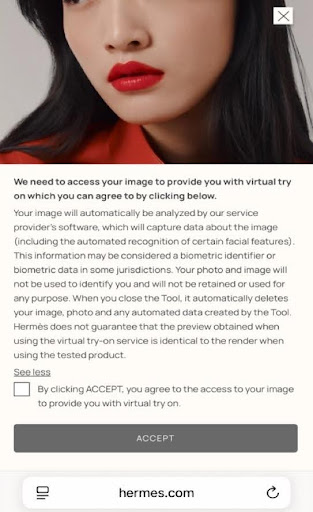
Intellectual Property Safeguards
Luxury fashion houses thrive on exclusivity and uniqueness – every elegant work of art brought to the runway is seamlessly stitched with Intellectual Property Rights [“IPR”]. This carefully woven ensemble of rights, safeguarding both creative and intellectual outputs, forms the cornerstone of a successful fashion retail experience. From brand conception to design curation, IP protection preserves the creative vision, legacy, and identity of these luxury labels. When viewed from a digital lens, IPR concerns inevitably assume significance – if AI is the designer, then who would wear the crown of authorship? This section primarily focuses on two fundamental dimensions: first, authorship and copyright protection for AI-generated fashion designs, drawn from a cross-jurisdictional perspective; and second, patentability of AR technologies deployed by luxury fashion retailers.
Copyright Protection for AI-Generated Designs
Indian Perspective
The Indian Copyright Act, 1957 while defining the scope of an ‘author’, explicitly refers to a ‘person’ as the creator of literary, dramatic, artistic and other related works. The Supreme Court of India’s landmark ruling in Eastern Book Company v. D.B. Modak further emphasized that works must demonstrate ‘human creativity and originality’, which can be interpreted to suggest that entirely AI-generated designs or works may not qualify for copyright protection. This interpretation was recently put to the test in the assessment of the Robust Artificially Intelligent Graphics and Art Visualizer [RAGHAV] tool, where the Copyright Office refused registration of AI-generated artwork, reaffirming the human-centric paradigm of authorship under the Indian copyright regime. Beyond judicial and administrative decisions, policy discourse continues shaping the AI-IPR conundrum, with the 161st Parliamentary Standing Committee’s recommendations for establishing a dedicated framework to address AI-generated works and inventions, acknowledging the lacuna in the existing frameworks to incorporate emerging technological creativity.
EU Perspective
Under the EU copyright framework, the “personal touch” and “free and creative choices” standards may provide protection for AI-assisted designs where human designers make sufficient contributions to AI outputs, and not independent AI results. Purely AI-generated derivative designs may risk falling into the public domain, creating vulnerability for luxury brands seeking strong IP protection against their designs and creative works.
U.S. Perspective
Under the current U.S. copyright law framework, works created solely by AI cannot receive copyright protection owing to the lack of human authorship, as was held by the U.S. Court of Appeals in Thaler v. Perlmutter. However, AI-assisted designs involving “sufficient human creative input” may still qualify for protection, leading to a complex spectrum of ownership rights. This position implies that virtual assistance may be copyrightable if designers and luxury labels maintain substantial creative control throughout the design curation process.
When it comes to the authorship of AI-generated designs, it is imperative for designers and artists to retain their creative reins – utilizing virtual assistance as a muse, not the master. The absence of the human hand at the sketching table strikes at the very essence of authorship. Therefore, this technology must be employed only as a tool of assistance, and never by handing over the digital paintbrush and portfolio to these systems. This is particularly significant with high-end fashion brands expanding their presence into the realm of digital creativity – last month, in a fashionably pioneering move, Guess introduced a fully AI-generated model, styled in its summer collection, for the August 2025 print edition of Vogue. This brings the issue of virtually curated and displayed designs into the spotlight. Even brands at the aspirational tier leaning towards high-end product lines and ‘slow-fashion’, such as Selkie, showcased AI-generated designs for its 2024 Valentine’s Day collection titled ‘Home Is Where the Heart Is’. The brand received substantial backlash after consumers noticed a design featuring an animal motif with an unusual number of toes – confirming that the collection was indeed curated using AI.
Patent Protection for AI-Driven Fashion Technology
Although the interplay of AI-generated works and copyright protection remains at the core of the legal implications surrounding the virtual luxury ecosystem, IP safeguards extend beyond artistic innovations. The bedrock of AI-powered assistance, i.e., the technology that sparks these mechanisms to create fashion retail magic, including virtual try-on features and biometric-driven personalization engines relying on the integration of AR and virtual reality [“VR”] technologies, further raises concerns about the Patentability of these systems. Patentable inventions and innovations, unlike copyright, which evaluates creative outputs based on a modicum of creativity, are assessed on the parameters of novelty, non-obviousness and industrial application.
Patents in this sphere protect the ‘architecture of AI’, including computer vision algorithms integrated for UI element recognition, machine learning models, automated systems, with advanced models even covering transformer models. When viewed through the lens of luxury fashion retail, patents in the digital atelier drape protection over AR interfaces offering virtual styling, try-on features, and personalized recommendation engines; methods employed for identifying, blending and generating visual elements and designs, and technologies applying neural networks and machine learning mechanisms for predictive analytics and demand forecasting.
Patent infringement claims in luxury fashion retail have had their day on the litigation runway as well – Zugara Inc., a California-based AR company, sued Estée Lauder over its virtual try-on ‘Try Before You Buy’ feature, alleging patent infringement over its AR technology [Zugara’s Patent No. 10,482,517]. While this conflict resulted in a mutual settlement, such cases underscore the importance of IPR protection in cultivating a fair, transparent, and innovative luxury retail space.
Creativity, innovation and groundbreaking technology run through the veins of the fashion industry. Be it safeguarding designs or protecting technology, the glamorous world can never afford to lose its legal lens. After all, the fabrics must be strong enough to stitch a long-lasting dress – in the same way, the fashionable encounter between atelier and algorithm can only endure when swathed in fine legal safeguards.
Beyond Breakfast: Can AI Serve a Full-Course Meal in Luxury Fashion Retail?
AI has proven to be a transformative catalyst in fashion, sprinkling glitter all over the traditional fashion retail experience. While this technological embedding offers a promising vision that could redefine the future of luxury fashion retail, its legal and ethical implications cannot go unaddressed, and must be resolved with care. Apart from legal obligations, the infusion of AI into luxury fashion retail also poses several ethical dilemmas spanning inclusivity concerns, algorithmic bias, misrepresentation, authenticity, and sustainability of AI-driven solutions.
The perks of blending AI into this industry are abundant. However, the glam comes with a trail of grey threads – consumers remain sharply loyal to human interaction and in-person experiences, with over 71% respondents in a survey categorically denying their chances of visiting or engaging with a brand in the absence of human customer service representatives. Additionally, AI’s data limitations, in terms of heavily relying upon extensive datasets to process and generate patterns, make it vulnerable to inaccuracies, biases and hallucinations. Unprecedented disruptions, such as natural calamities, system failures, or unauthorized use of personal data, further add to the perils of incorrect processing of information, all of which, if not utilized carefully, may be fatal to brand integrity. Additionally, there are pressing concerns over job displacement in the creative industry, with many fearing that AI may be redefining fashion’s workforce, an issue that cannot be neglected.
Looking forward, the future of AI in luxury fashion retail depends on balance. Judicious, mindful usage of AI, rather than unregulated integration, will allow technology to complement human intelligence and creativity, rather than replace it. This breakfast has the potential of transforming into a full-course feast if stakeholders involved in the luxury fashion retail experience build accountability, harmony, trust, along with adherence to legal and ethical governance standards. Smoother, fashionable encounters between the code and couture may be better secured if stakeholders:
- Document Human Involvement in AI-Generated Content: Establishing systematic record-keeping protocols capturing human inputs – including prompts, workflows, and creative decisions can demarcate genuine collaborative creations from purely independent AI-driven outputs. If put to practice, recorded evidence showcasing human involvement in AI-assisted design curations can help in determining authorship claims.
- Train AI Responsibly: AI models should be trained on lawfully sourced datasets that incorporate registered and protected designs, in order to reduce the risk of inadvertent replication of prior existing art.
- Develop In-House AI Solutions: Developing Proprietary AI platforms can strengthen the protection of sensitive data while granting luxury fashion houses adequate control over creative parameters and model outputs. Additionally, technological integration aligned with brand ethos ensures that digitally generated content enhances, rather than dilutes, the brand’s creative vision.
Fostering collaboration among agencies, stakeholders, and governmental authorities can pave the way for a unified regulatory framework that protects consumers while safeguarding the operations and intellectual property of luxury fashion houses. AI can truly serve as a revolutionary tool in this sector, but only if wielded wisely. As Catriona Gray aptly said, “Everything is good, but in moderation” – a principle that resonates perfectly at the intersection of code and couture.
Breakfast at Tiffany’s has the potential to transform into a full feast; if just the right amount of champagne is poured at the table.
References:
[1] Hermès Virtual Makeup Try-On, Hermès Paris, last accessed Sept. 12, 2025 <https://www.hermes.com/us/en/category/make-up/lips/#|>.
[2] Prada Group Tailors their AI Strategy with Data Intelligence, Databricks, last accessed Sept. 12, 2025 < https://www.databricks.com/customers/prada-group>.
[3] Case Study: Prada Integrates AI for the Future of Luxury Fashion, AI Expert Network, last accessed Sept. 12, 2025 < https://aiexpert.network/prada-ai/>.
[4] Oleksandra Baukh, How Artificial Intelligence is Revolutionizing the Fashion Industry, Techpacker, last accessed Sept. 12, 2025 < https://techpacker.com/blog/design/how-artificial-intelligence-is-revolutionizing-the-fashion-industry/>.
[5] Louis Vuitton Reinvents the Beauty Universe with La Beatué Louis Vuitton, LVMH, last accessed Sept. 13, 2025 < https://www.lvmh.com/en/news-lvmh/louis-vuitton-reinvents-the-beauty-universe-with-la-beaute-louis-vuitton>.
[6] Luxury Fashion Houses Expand into India’s Beauty Market, Luxuri, last accessed Sept. 12, 2025 < https://www.luxurimag.com/news/luxury-fashion-houses-expand-into-indias-beauty-market/>.
[8] R. Santos Paulo, AI-Powered Virtual Try-Ons in the Fashion Industry, Everyday IT, last accessed Sept. 12, 2025 < https://www.ai-infra-link.com/ai-powered-virtual-try-ons-in-the-fashion-industry/>.
[9] Id.
[10] Virtual Try-On Technology for the Luxury Industry: How It Works, Benefits & Challenges, Wanna Fashion, last accessed Sept. 13, 2025 < https://wanna.fashion/blog/virtual-try-on-technology-for-luxury-industry>.
[11] Virtual Try On, Chanel, last accessed Sept. 13, 2025 < https://www.chanel.com/in/makeup/virtual-makeup-try-on/>.
[12] Image Source <1752162232817-lesbeigescollectionp1wwjpg_2025x1620.jpg>.
[13] Patrick Johnson, Augmented Reality in Fashion, Rock Paper Reality, last accessed Sept. 13, 2025 <https://rockpaperreality.com/insights/ar-use-cases/augmented-reality-in-fashion/>.
[14] Style DNA, last accessed Sept. 15, 2025 < https://styledna.ai>.
[15] Style DNA App (images retrieved Sept. 15, 2025).
[16] Fashion Chatbot, Hyper Space, last accessed Sept.13, 2025 <https://hyperspace.ai/fashion-chatbot-ai>.
[17] CGS Survey Reveals Consumers Prefer a Hybrid AI/ Human Approach to Customer Service. Is there Chatbot Fatigue?, CGS, last accessed Sept. 14, 2025,< https://www.cgsinc.com/en/resources/2019-cgs-customer-service-chatbots-channels-survey>.
[18] Ralph Lauren Introduces Ask Ralph, A New Conversational Shopping Experience, Ralph Lauren Corporation, last accessed Sept. 15, 2025, < https://corporate.ralphlauren.com/pr_250909_AskRalph.html>.
[19] Ask Ralph| Virtual Styling & Shopping Assistant, Ralph Lauren < https://www.ralphlauren.com/askralphinfo>.
[20] Dr. Hardy Kremer, Transforming Luxury Fashion Inventory Management with Generative AI, OMMAX, last accessed Sept. 15, 2025 <https://www.ommax.com/en/insights/industry-insights/transforming-luxury-fashion-inventory-management-with-generative-ai/>.
[21] Id.
[22] AI in Inventory Management for Fashion Stores: How Are Brands Using It?, Connect POS, last accessed Sept. 15, 2025 < https://www.connectpos.com/ai-in-inventory-management-for-fashion-stores-how-are-brands-using-it/>.
[23] Id.
[24]Future of Inventory Management: How AI Forecasting is Revolutionizing Supply Chains in 2025, Super AGI, last accessed Sept. 15, 2025 < https://superagi.com/future-of-inventory-management-how-ai-forecasting-is-revolutionizing-supply-chains-in-2025/>.
[25] Harnessing the Power of AI in distribution operations, McKinsey & Company, last accessed Sept. 15, 2025 < https://www.mckinsey.com/industries/industrials-and-electronics/our-insights/distribution-blog/harnessing-the-power-of-ai-in-distribution-operations>.
[26] Supra Note 23.
[27] How Top Fashion Brands Use Artificial Intelligence, WFX, last accessed Sept. 16, 2025 < https://www.worldfashionexchange.com/blog/artificial-intelligence-in-fashion/#:~:text=resulting%20in%20a%20more%20agile,and%20sustainable%20supply%20chain>.
[28] Emily Seares, Could Generative AI Solve Fashion’s Excess Stock Problems?, Vogue Business, last accessed Sept. 16, 2025 < https://www.voguebusiness.com/technology/could-generative-ai-solve-fashions-excess-stock-problems>.
[29] Supra Note 4.
[30] Chrystal R. China, What is Product Lifecycle Management (PLM)?, IBM, last accessed Sept. 16, 2025 < https://www.ibm.com/think/topics/product-lifecycle-management>.
[31] Supra Note 4.
[32] Giulia Abello et al., Mastering Supply Chain Management in the Luxury Fashion Industry, TNP, last accessed Sept. 16, 2025 < https://www.tnpconsultants.com/wp-content/uploads/2024/11/Mastering-Supply-Chain-Management-in-the-Luxury-Fashion-Industry.pdf>.
[33] How AI Fashion Trend Forecasting is Revolutionizing Retail – A Data- Driven Approach to Consumer Insights, Matellio, last accessed Sept. 16, 2025 < https://www.matellio.com/blog/ai-fashion-trend-forecasting-for-retail/>.
[34] Id.
[25] Supra Note 4.
[36] Id.
[37] The Next Big Thing: How AI is Shaping Fashion Trends, Glance, last accessed Sept. 16, 2025 < https://glance.com/us/blogs/glanceai/ai-shopping/the-next-big-thing-how-ai-is-shaping-fashion-trends#section10>.
[38] Holger Harreis et al., Generative AI: Unlocking the Future of Fashion, McKinsey & Company, last accessed Sept. 16, 2025 < https://www.mckinsey.com/industries/retail/our-insights/generative-ai-unlocking-the-future-of-fashion>.
[39] Id.
[40] AI Fashion Design, The New Black < https://thenewblack.ai>.
[41] Elektra Kotsoni, Style vs Craft: Turning AI Designs into IRL Clothes, Vogue, last accessed Sept. 16, 2025 < https://www.voguebusiness.com/story/fashion/taste-vs-craft-turning-ai-designs-into-irl-clothes>.
[42] Alicia Arnold, The dark side of virtual try-on tools: Safeguarding biometric data, Martech, last accessed Sept. 17, 2025 < https://martech.org/the-dark-side-of-virtual-try-on-tools-safeguarding-biometric-data/>.
[43] Richard Wilson & Olivia Bowles, Artificial Intelligence and Trend Forecasting in the Fashion Industry: Ethical and Anticipated Ethical Issues, 4 ICAIR 1 (2024).
[44] What is an API (application programming interface)?, IBM, last accessed Sept. 19, 2025 < https://www.ibm.com/think/topics/api>.
[45] Supra Note 42.
[46] Temiloluwa Adebowale, The Role of Natural Language Processing In Fashion E-commerce, Woven Insights, last accessed Sept. 20, 2025 < https://woveninsights.ai/site-blog/the-role-of-natural-language-processing-in-fashion-e-commerce/>.
[47] Id.
[48] Alvin Antony, A general introduction to Artificial Intelligence Law in India, Lexology, last accessed Sept. 21, 2025 < https://www.lexology.com/library/detail.aspx?g=4f351c27-aaf5-4447-9abc-23c0f9bd0c58>.
[49] Sanjeev Sanyal , Pranav Sharma, & Chirag Dudani, A Complex Adaptive System Framework to Regulate Artificial Intelligence, EAC-PM/WP/26/2024.
[50] The Digital Personal Data Protection Act, 2023, No. 22 of 2023 (India).
[51] India well-equipped to tackle evolving online harms and cyber crimes; Government to Parliament, Press Information Bureau, last accessed Sept. 20, 2025 < https://www.pib.gov.in/PressReleasePage.aspx?PRID=2154268>.
[52] DPDP Act Explained: What Every Business Needs to Know, Sekel Tech, last accessed Sept. 17, 2025 < https://sekel.tech/blog/dpdp-act-explained-what-every-business-needs-to-know>.
[53] The Information Technology Act, 2000, No. 21, Acts of Parliament of 2000 (Ind.) hereinafter referred to as “IT Act 2000”.
[54] IT Act 2000, § 66D.
[55] IT Act 2000, § 66E.
[56] Information Technology (Intermediary Guidelines and Digital Media Ethics Code) Rules, 2021, Ministry of Electronics and Information Technology, last accessed Sept. 22, 2025 < https://www.meity.gov.in/static/uploads/2024/02/Information-Technology-Intermediary-Guidelines-and-Digital-Media-Ethics-Code-Rules-2021-updated-06.04.2023-.pdf> hereinafter referred to as “IT Rules” .
[57] Supra Note 48.
[58] IT Rules, Rule 3(2)(B).
[59] Stay Safe from AI-Generated Morphed Images, Red Team Cyber Security Labs, last accessed Sept. 22, 2025 < https://theredteamlabs.com/stay-safe-from-ai-generated-morphed-images/#elementor-toc__heading-anchor-2>.
[60] General Data Protection Regulation, Intersoft Consulting < https://gdpr-info.eu>.
[61] EU Artificial Intelligence Act < https://artificialintelligenceact.eu/assessment/eu-ai-act-compliance-checker/>.
[62] Oliver Yaros et al., EU AI Act: Ban On Certain AI Practices And Requirements For AI Literacy Come Into Effect, Mayer| Brown, last accessed Sept. 17, 2025 < https://www.mayerbrown.com/en/insights/publications/2025/01/eu-ai-act-ban-on-certain-ai-practices-and-requirements-for-ai-literacy-come-into-effect>.
[63] Cal. Civ. Code § 1798.100 et seq.
[64] AI in fashion — the legal risks around rights, ownership and design protection, Brabners, last accessed Sept. 17, 2025 < https://www.brabners.com/insights/retail-leisure/ai-in-fashion-the-legal-risks-around-rights-ownership-and-design-protection>.
[65] Theriot v. Louis Vuitton N. Am., Inc., No. 1:22-cv-02944 (S.D.N.Y. Dec. 5, 2022).
[66] Biometric Information Privacy Act, 740 Ill. Comp. Stat. 14/1 et seq. (2008).
[67] Akshay Kumar, Base64 Encoding: What Is It? How Does It Work?, Built In, last accessed Sept. 22, 2025 <https://builtin.com/software-engineering-perspectives/base64-encoding>.
[68] Emory Odom, Luxury Fashion Label Dior Notifies Customers of Data Exposure, The National CIO Review, last accessed Sept. 23, 2025 < https://nationalcioreview.com/articles-insights/information-security/luxury-fashion-label-dior-notifies-customers-of-data-exposure/>.
[69] Aninda Chakraborty, Cartier hit by data breach as cyberattacks on fashion brands surge, Tech Monitor, last accessed Sept. 22, 2025 < https://www.techmonitor.ai/technology/cybersecurity/cartier-data-breach?cf-view&cf-closed&cf-closed&cf-closed&cf-closed&cf-closed&cf-closed>.
[70] Louis Vuitton hit by major data breach in Hong Kong affecting 419,000 customers, StoryBoard, last accessed Sept. 23, 2025 < https://www.storyboard18.com/brand-marketing/louis-vuitton-hit-by-major-data-breach-in-hong-kong-affecting-419000-customers-75913.htm>.
[71] The Consumer Protection Act, 2019, No. 35 of 2019, Acts of Parliament (Ind.).
[72] Central Consumer Protection Authority issues ‘Guidelines for Prevention and Regulation of Dark Patterns, 2023’ for prevention and regulation of dark patterns listing 13 specified dark patterns, Press Information Bureau, last accessed Sept. 17, 2025 < https://www.pib.gov.in/PressReleaseIframePage.aspx?PRID=1983994>.
[73] Govt launches AI tools, ecommerce safety measures to boost consumer protection, The Economic Times, last accessed Sept. 17, 2025 < https://retail.economictimes.indiatimes.com/news/industry/govt-launches-ai-tools-ecommerce-safety-measures-to-boost-consumer-protection/116629507>.
[74] Reliance Retail signs consumer safety pledge with Ministry of Consumer Affairs, The Economic Times, last accessed Sept. 23, 2025 < https://retail.economictimes.indiatimes.com/news/industry/govt-launches-ai-tools-ecommerce-safety-measures-to-boost-consumer-protection/116629507>.
[75] Theriot, No. 1:22-cv-02944, at 13.
[76] Sunglasses, Virtual Try-On, Louis Vuitton <https://in.louisvuitton.com/eng-in/women/accessories/sunglasses/_/N-t1peha6j>.
[77] Fragrances and Make-Up, Virtual Try-On, Hermès < https://www.hermes.com/us/en/category/make-up/lips/#|>.
[78] The Copyright Act, 1957, No. 14, Acts of Parliament, 1957 (Ind.), hereinafter referred to as “Copyright Act 1957”.
[79] Copyright Act 1957, §2(d).
[80] Eastern Book Company & Ors v. DB Modak & Anr, AIR 2008 SC 809.
[81] Mohd Nasir Alam & Vatsal Chaudhary, Copyright Law in the age of AI: Analyzing The AI-Generated Works
and Copyright Challenges in India, 6 Ijpr 5587-5591 (2025).
[82] Department-Related Parliamentary Standing Committee on Commerce, Rajya Sabha, 161st Report: Review of the Intellectual Property Rights Regime in India (2021) < https://drive.google.com/file/d/1L-9ugGmHIwFZTskpeillFE2yzYeippYu/view>.
[82] Ioanna Lapatoura & Mark Jetsaphon Niyompatama, Generative AI in Fashion Design Creation: A Copyright Analysis of AI-Assisted Designs, J. Intell. Prop. L. & Prac. (2025).
[83] Thaler v. Perlmutter, 130 F.4th 1039 (D.C. Cir. 2025).
[84] Hassan Gaffar & Saif Albarashdi, Copyright Protection for AI-Generated Works: Exploring Originality and Ownership in a Digital Landscape, 15 Asian J. Int’l L., 23–46 (2025).
[85] Yasmin Rufo, Does this look like a real woman? AI model in Vogue raises concerns about beauty standards, BBC, last accessed Sept. 24, 2025 < https://www.bbc.com/news/articles/cgeqe084nn4o>.
[86] Sarah Bregel, Can a brand use AI and still be a part of the ‘slow fashion’ movement? Selkie thinks so, BBC, last accessed Sept. 25,2025 < https://www.bbc.com/worklife/article/20240124-can-a-brand-use-ai-and-still-be-a-part-of-the-slow-fashion-movement-selkie-thinks-so>.
[87] Fashion Patents, Wilson Dutra, last accessed Sept. 25, 2025 < https://www.wilsondutra.com/fashion-patents/>.
[88] Rahul Dev, AI Innovation Patents, Patent Business Lawyer, last accessed Sept. 22, 2025 < https://patentbusinesslawyer.com/writing-patents-for-ai-interface-detection-technology/>.
[89] Supra Note 86.
[90] Supra Note 12.
[91] Mallory Culhane, Estée Lauder Settles in Virtual Try-On Patent Infringement Suit, Bloomberg Law, last accessed Sept. 24, 2025 < https://news.bloomberglaw.com/litigation/estee-lauder-settles-in-virtual-try-on-patent-infringement-suit>.
[92] Benedetta Giovanola et al., Ethical Implications of Artificial Intelligence in the Fashion Industry: A Comprehensive Analysis, 2 Fashion Highlight, 22 – 28 (2023).
[93] Gil Press, AI Stats News: 86% Of Consumers Prefer Humans To Chatbots, Forbes, last accessed Sept. 19, 2025 < https://www.forbes.com/sites/gilpress/2019/10/02/ai-stats-news-86-of-consumers-prefer-to-interact-with-a-human-agent-rather-than-a-chatbot/>.
[94] Supra Note 19.
[95] Savannah Fortis, How AI is reshaping fashion’s workforce, Vogue Business, last accessed Sept. 25, 2025 < https://www.voguebusiness.com/story/technology/how-ai-is-reshaping-fashions-workforce>.








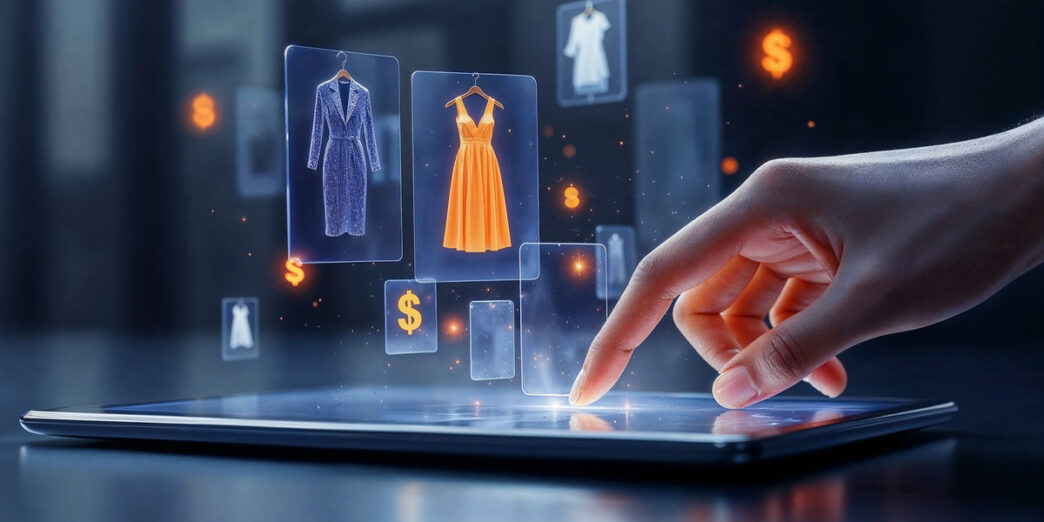






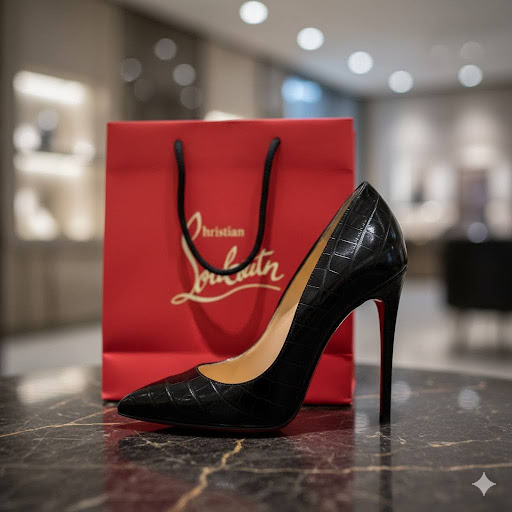

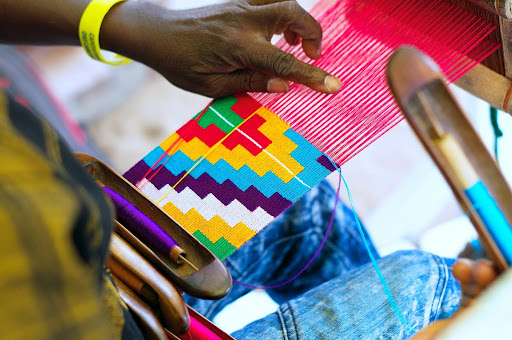

This is one of the best Articles I have ever read!
Great job-very informative and well drafted!!